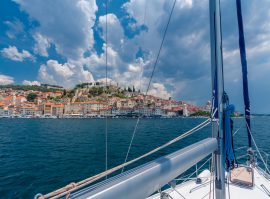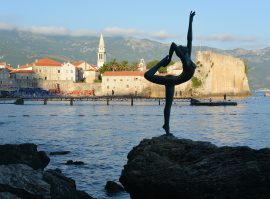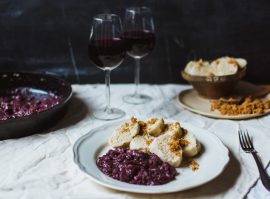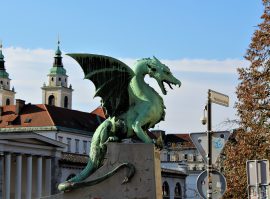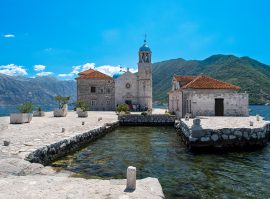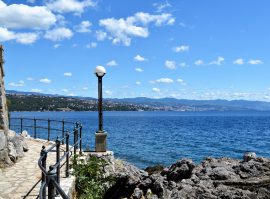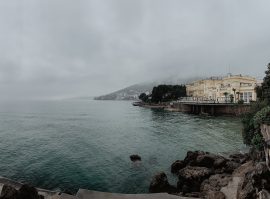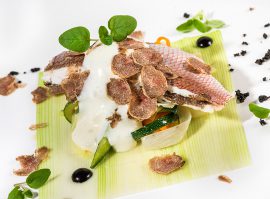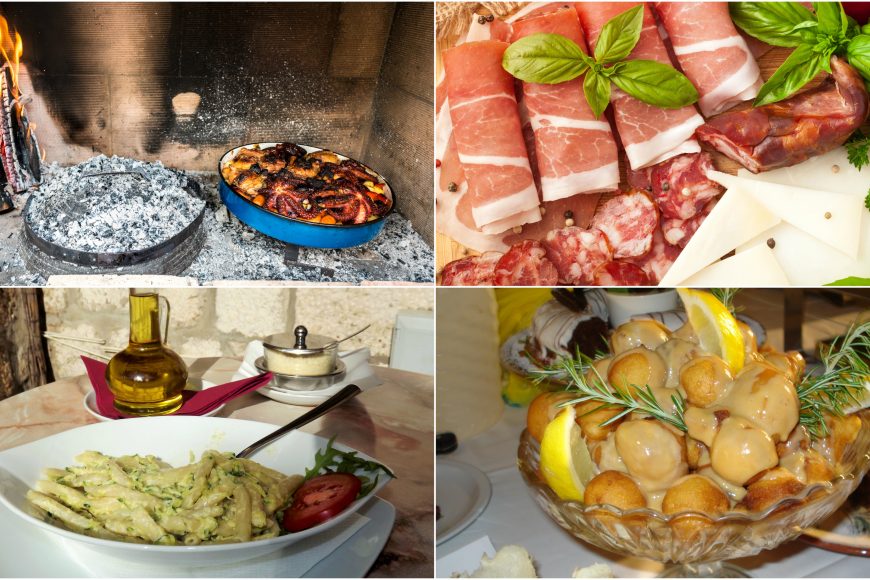
Tastes of Croatia
When I’m planning a trip to a new country, one of the things I definitely put on my “must do” list is – try traditional food. Let me tell you something more about Croatian food and suggest you a few delicacies you don’t want to miss trying. 🙂
Geographical position and historical events have left a great impact on Croatian cuisine. The biggest influence comes from Italian, Turkish and Hungarian cuisine that you can feel travelling from one region to another. Croats are very proud of this heritage that they nurture and enjoy on a daily basis.
Croatian traditional food can be divided into two categories: Mediterranean (coastal) and Continental cuisine. Mediterranean cuisine is based on seafood, olive oil and herbs and spices such as sage, bay leaf, rosemary and basil while Continental is mainly based on meat, cabbage, paprika and stronger spices like black pepper.
Let’s start with the appetizer
Prosciutto and cheese
Most popular cold appetizer would be prosciutto specific for drying in the cold and dry wind bura. It’s often served on a platter together with cheese: paski sir from the island of Pag is the most famous – a hard, piquant cheese with a taste somewhere between Parmesan and mature cheddar.
Strukli from Zagorje
Another dish that can be served as an appetizer but also as a main course is Strukli. It is characteristic for Zagorje region and Zagreb. It comes in two forms: kuhani (boiled) strukli are large parcels of dough filled with cottage cheese, while for peceni (baked) strukli the dough and cheese are baked in an earthenware dish, resulting in a cross between cheese soufflé and lasagne.
PS: If you are in Zagreb don’t forget to visit charming ‘LaStruk’ restaurant and try one of the numerous types it offer. You can choose between sweet or salty, with fruit or vegetables. Whichever you choose, you will be thrilled!
Turkey with Mlinci
Zagorje is also famous for its turkey with mlinci dish. Mlinci are thin, dried flatbread that is broken up into pieces and mixed with the roasting juices from a roast turkey. The juices make the mlinci soft and somewhat like noodles. They suck up all those delicious juices and carry a turkey flavour. This specialty from Zagorje is reserved for special occasions with every chef hiding his or her secret for the perfect roast turkey. If you are visiting Zagorje, try to find out some of the secrets that make turkey with mlinci so delicious.
Fuzi (Istrian pasta) with truffles
Truffles are one of the trademarks of Istria and a true delicates. This esteemed mushroom, that grows bellow the ground, is considered to be a gem of gastronomy in Istria. Although in many restaurants in Istria you can taste truffles combined with other dishes, it is a truly amazing gastronomic experience to taste them with fuzi pasta – another Istrian specialty. There are stories that truffles are an aphrodisiac, but that is something we will leave for you to discover.
Under the ‘peka’ dishes
Peka is not really a food but a method of cooking food. The peka is a dome or bell-shaped terracotta or steel lid that you heat by burning wood below it. Once heated, the food is placed in a round shaped tray underneath the peka and put embers on top of the peka itself which then cooks the food. What can be cooked in peka? Basically any tipe of fish or meat. In Croatia, the most famous dishes under the peka are octopus and lamb. They are usually combined with potatos and seasonal vegetables. The divine taste of dishes under the peka is a result of this unique way of cooking that is much slower than usual.
Black Risotto
Black Risotto is basically a squid risotto. Squid ink is preserved and used in cooking to give that black color to the rice. Besides squids, this risotto contains other seafood, particularly mussels, clams and other shellfish. Although the risotto seems like a simple dish, the secret is in choosing the right type of rice, with creamy texture that connects all the flavours into one. Black Risotto is simply a must-try Croatian dish.
Pasticada
Called a “Queen of Dalmatian cuisine”, pasticada is perhaps the most popular meat dish in Dalmatia. The preparation of pasticada starts with marinating beef’s fillet in a wine vinegar for a few days. The meat is then braised for a few hours, first in its own juice and later with red wine. It is served with delicious home made gnocchi. Even though the process of making pasticada is a bit longer, believe me, when you try it you will understand why it is worth the time.
Skampi na buzaru
Mussels, oysters and scampi are prepared ‘na buzaru’ (a method of cooking seafood) in Dalmatian region. They are placed in a pot and covered with grated parsley, garlic, bread crumbs, salt, pepper, wine and oil. Tomato paste is sometimes added for color. This is the best way to experience tasty Adriatic prawns so don’t forget to try ‘buzara’ while you are in Dalmatia.
Finally! It’s time for something sweet. If you are a dessert lover, such as I am, I am sure you have been waiting for some sweet treats since the appetizer arrived! 😀
Let’s see what Croatia offers.
Fritule
The most common sweets you’ll find in coastal Croatia are fritule – a ball shaped dough made with flour, sometimes raisins, a touch of local schnapps and lemon zest, and then deep fried. The recipe and the extra ingredients differ from one region to another. This small fried dough ball is made fresh and topped with your favorite add-on. Be careful, these sweet balls can be very addictive, and hard to say ‘no’ to. 🙂
Rozata
Rozata or rožata is a Dalmatian version of crème caramel. It is especially typical for Dubrovnik area and they call it rozata. The difference between rozata and rožata is that in Dubrovnik they add traditional liqueur made of rose petals as well as raisins, arancini (candied bitter orange peel) and almonds, while in other parts of Dalmatia they don’t. You will find rozata/rožata in almost every tavern or restaurant in Dalmatia.
When you visit Croatia make sure to try at least one of these traditional dishes. You will be delighted!
Bon appetit! 🙂




